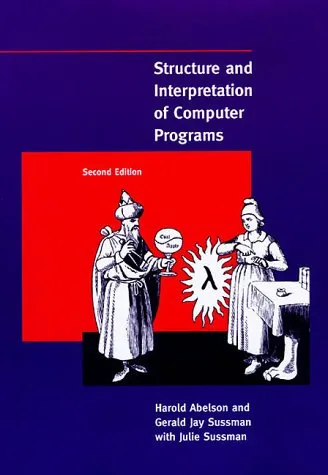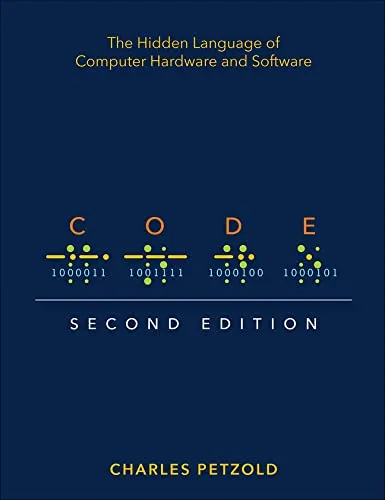Structure and Interpretation of Computer Programs - 2nd Edition
4.5
بر اساس نظر کاربران

شما میتونید سوالاتتون در باره کتاب رو از هوش مصنوعیش بعد از ورود بپرسید
هر دانلود یا پرسش از هوش مصنوعی 2 امتیاز لازم دارد، برای بدست آوردن امتیاز رایگان، به صفحه ی راهنمای امتیازات سر بزنید و یک سری کار ارزشمند انجام بدینکتاب های مرتبط:
Persian Summary
معرفی کتاب "Structure and Interpretation of Computer Programs - 2nd Edition"
کتاب "Structure and Interpretation of Computer Programs" یا به اختصار SICP اثر هارولد ابلسون و جرالد جی. ساسمن از مهمترین کتب در حوزه برنامهنویسی و علوم رایانه است. این کتاب به بررسی اصول پایهای و ساختارهای اساسی در برنامهنویسی میپردازد و ابزارهای مفهومی برای حل مسائل پیچیده را معرفی میکند.
خلاصهای از کتاب
این کتاب در اصل به عنوان کتاب درسی دورههای اولیه علوم رایانه در دانشگاهها تدریس میشود و تاکید اصلی آن بر روی روشهای اساسی درک و تفسیر برنامهها است. نویسندگان با استفاده از زبان برنامهنویسی Scheme، به شبکهای پیچیده از مفاهیم همچون abstraction، modularity، و recursion پرداختهاند. این مفاهیم با استفاده از مثالهای عملی و پروژههای کوچک، پلهپله به خوانندگان آموزش داده میشود و فهم عمیقی از چگونگی ساخت برنامههای موثر، قابل نگهداری و منعطف ارائه میدهد.
نکات کلیدی کتاب
- درک عمیق از مفهوم abstraction و چگونگی استفاده از آن در ساخت برنامهها.
- اهمیت modularity در طراحی و توسعه سیستمهای نرمافزاری.
- استفاده از recursion به عنوان ابزار اصلی تکرار و کنترل جریان.
- تفسیر دقیق از دادهها و فرایندها در قالب objects و مدلهای داده.
جملات مشهور از کتاب
«برنامهنویسی چیزی بیش از نوشتن کد نیست؛ این هنر طراحی سیستمهایی است که نیازهای کاربران را به شکلی ساده و مستقیم پاسخ دهد.»
«مثالهای زندگی واقعی بهترین منبع یادگیری و الهام برای ایجاد برنامههای جدید و نوآورانه هستند.»
اهمیت این کتاب
کتاب SICP به عنوان یکی از بهترین منابع آموزشی در زمینه علوم رایانه شناخته میشود. این کتاب بنیادین است و به دانشجویان و برنامهنویسان حرفهای کمک میکند تا مهارتهای تفکر انتقادی و حل مسئله خود را تقویت کنند. اهمیت این کتاب تنها در آموزش تکنیکهای برنامهنویسی نیست، بلکه در آموزش روشهای تفکر و طراحی نرمافزار میباشد. تبلیغ این کتاب به عنوان یک منبع حیاتی درک عمیقتری از دنیای پیچیده و مداوم برنامهنویسی و محاسبات را به همراه دارد و دانشجویان را برای مواجهه با چالشهای آینده آماده میکند.
Introduction to "Structure and Interpretation of Computer Programs - 2nd Edition"
The "Structure and Interpretation of Computer Programs" (SICP) is a computer science textbook that has fundamentally shaped the education of students in programming and beyond. Crafted by Harold Abelson and Gerald Jay Sussman with Julie Sussman, this book provides an unparalleled narrative on the essence of computer programming.
Detailed Summary of the Book
In its second edition, SICP continues to offer a profound exploration of the abstract concepts that power modern computing. The book walks the reader through programming paradigms, data structures, and problem-solving techniques. It meticulously illustrates how to frame and abstract complex programs and systems using a clear, elegant expression of ideas. Through the lens of Scheme, a dialect of Lisp, the authors emphasize programming as a means to communicate effectively with both humans and machines.
The book is divided into five chapters, each addressing a critical facet of programming:
- Building Abstractions with Procedures: This chapter focuses on the fundamental techniques for creating abstractions in programming, stressing the importance of expressions and procedures.
- Building Abstractions with Data: The authors delve into data representation and the techniques for structuring data that support the program's semantic requirements.
- Modularity, Objects, and State: Introducing the concept of stateless programming and the implications of introducing state, this chapter examines the balance between stateful techniques and the architectural complexity they introduce.
- Metalinguistic Abstraction: This chapter explores languages from a meta perspective, discussing interpreters and compilers that form the backbone of programming languages.
- Computing with Register Machines: This chapter investigates the low-level abstractions of computing, emphasizing the design and implementation of register machines.
Key Takeaways
- Understanding abstraction is crucial to resolving complexity in software engineering.
- Functional programming promotes a purer form of computation with higher predictability and robustness.
- The principles and paradigms discussed transcend specific programming languages, thereby applying to a broader spectrum of computational systems.
- By understanding the underlying principles of language design, programmers can develop more efficient and expressive code solutions.
Famous Quotes from the Book
"Programs must be written for people to read, and only incidentally for machines to execute."
"A computer language is not just a way of getting a computer to perform operations but rather that it is a novel formal medium for expressing ideas about methodology."
Why This Book Matters
"Structure and Interpretation of Computer Programs" exerts a monumental influence on computer science education worldwide. The book does not merely teach programming; it reshapes how learners perceive the essence of computing. By dismantling the complexities of programming into foundational concepts, SICP fosters a deeper understanding of how software should be crafted and judged.
The ability to think critically about the very architecture of software systems is fostered through this book, making it an essential resource for aspiring programmers and seasoned developers alike. Its lessons on abstraction, recursion, higher-order functions, and state lay the groundwork for modern software development methodologies, influencing a vast array of subsequent technologies and frameworks.
In sum, SICP offers more than a framework for programming; it presents a philosophy of thought that challenges its readers to continually explore the evolving landscape of technology with curiosity and rigor.
دانلود رایگان مستقیم
You Can Download this book after Login
دسترسی به کتابها از طریق پلتفرمهای قانونی و کتابخانههای عمومی نه تنها از حقوق نویسندگان و ناشران حمایت میکند، بلکه به پایداری فرهنگ کتابخوانی نیز کمک میرساند. پیش از دانلود، لحظهای به بررسی این گزینهها فکر کنید.
این کتاب رو در پلتفرم های دیگه ببینید
WorldCat به شما کمک میکنه تا کتاب ها رو در کتابخانه های سراسر دنیا پیدا کنید
امتیازها، نظرات تخصصی و صحبت ها درباره کتاب را در Goodreads ببینید
کتابهای کمیاب یا دست دوم را در AbeBooks پیدا کنید و بخرید
1414
بازدید4.5
امتیاز50
نظر98%
رضایتنظرات:
4.5
بر اساس 0 نظر کاربران
"کیفیت چاپ عالی بود، خیلی راضیام"



